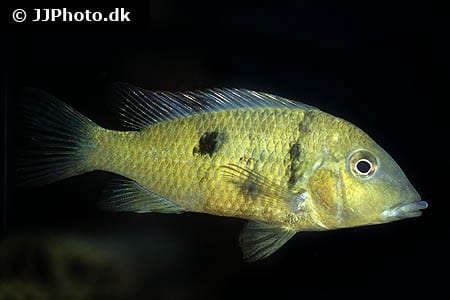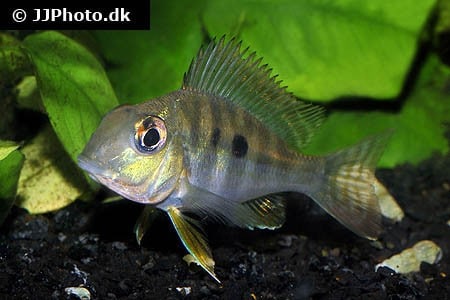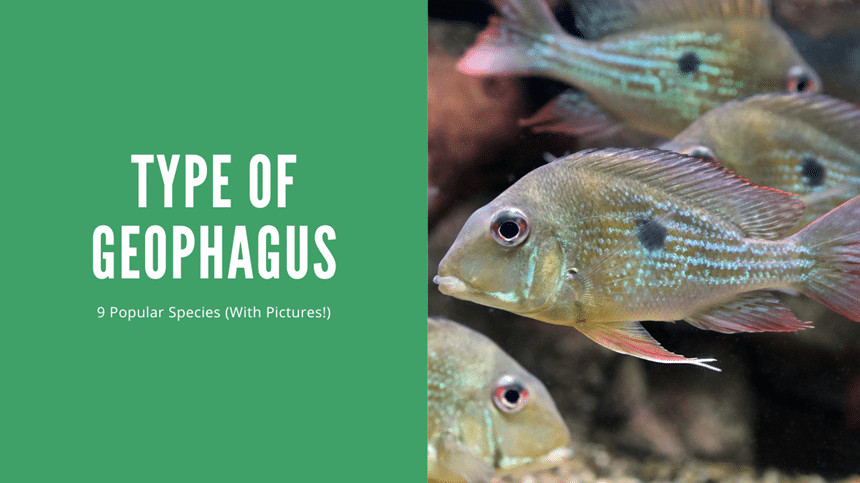Thank you for visiting! By the way… any links on this page that lead to products on Amazon and other stores/partners are affiliate links Aquarium Store Depot earns a commission if you make a purchase.
Cichlids are some of the most popular freshwater fish families in the aquarium trade, famous for their bold markings and colors, interesting behavior, and vibrant personalities. While many species have a reputation for aggression, one group of cichlids, the ‘earth eaters’ are known for their relatively peaceful temperament and amazing colors. Impact-Site-Verification: -1191795530
In this guide, I introduce 9 species of Geophagus cichlids, explain the basics of their care, and highlight what makes them such excellent freshwater aquarium fish.
Let’s get started!
Key Takeaways
- Geophagus are large to medium-sized South American cichlid fishes
- These fish are relatively peaceful and can be kept with a variety of tank mates. However, they may become aggressive when spawning
- Earth eaters require a relatively large aquarium (75 gallons+) and should be kept on a sandy substrate
- Identifying Geophagus can be tricky, so it’s best to buy from reputable breeders and sellers who can provide accurate information
Types Of Geophagus – 9 Beautiful Species
It’s time to learn about some of the most popular geophagus species that you can keep. In this section, I describe 9 earth-eating cichlid fishes that you are likely to find in the aquarium trade. Check out our video above from our YouTube Channel. We have more details in the blog post above.
Let’s dive right in!
1. Altifrons

- Origin: Amazon River Basin in Brazil
- Maximum size: Can reach over 10 inches
- Recommended temperature range: 79-89°F
- pH: 5-7
Characterized by the lack of vertical bars on its colorful body, Geophagus altifrons often have a pair of small spots on each flank. This species has a deep body shape with a steeply sloping forehead and develops long trailing tips on each fin, including paired caudal extensions.
G. altifrons are among the most popular eartheater species in the aquarium hobby, although they require a relatively large aquarium for long-term care. This species is one of the larger South American eartheaters and a small group will need a tank of over 100 gallons.
2. Brasiliensis

- Common name: Pearl cichlid
- Origin: Southeastern Brazil, Paraguay, and Uruguay
- Maximum size: Males up to about 11 inches and females up to 6 inches
- Recommended temperature range: 65-82°F
- pH: 6-8
Also known as the pearl cichlid, Geophagus brasiliensis is a beautiful freshwater fish characterized by an oval body shape and a dark vertical stripe through each eye. This species also has reddish fins, bright blue spots, and dark markings on its sides.
Geophagus brasiliensis has similar colors to other members of its genus although its body shape and habits are rather different. They will feed from the bottom, although they do not filter the substrate as often as other earth-eating cichlids.
3. Winemilleri

- Origin: Venezuela
- Maximum size: 8 inches
- Recommended temperature range: 65-82°F
- pH: 4-7
Geophagus winemilleri is a rare but particularly colorful species that can be identified by a dark spot on the lower jaw and long trailing tips and white edges to their red fins.
They have a series of broad and pale vertical bands on each side and the neon blue markings on their flanks are arranged in horizontal stripes rather than speckles, making this species particularly striking.
4. Sveni

- Origin: Brazil
- Maximum size: 7 inches
- Recommended temperature range: 76-84°F
- pH: 6-7.5
Geophagus sveni really pops with neon blue and can be distinguished from other earth-eating cichlid fish by the five pale vertical bars on its side and the lack of face markings. This colorful species also has a large blue spot on either side of its body and its tail is covered in glowing blue speckles often arranged in vertical columns.
G. sveni is a common species, that is suitable for moderately experienced aquarists.
5. Pellegrini

- Common name: Yellowhump eartheater
- Origin: Colombia
- Maximum size: 6 inches
- Recommended temperature range: 77-86°F
- pH: 5-6
G. pellegrini stands out with its yellowish coloration with dark vertical bars, shallow body shape, and pointed face. Males also develop a prominent hump on the top of the head, which explains why the species is commonly known as the yellowhump eartheater.
This species is at home in shallow, fast-flowing streams with various substrate types, although it will do well over a sandy substrate in the home aquarium.
6. Surinamensis

- Common name: Red striped eartheater
- Origin: Suriname and French Guiana
- Maximum size: 12 inches
- Recommended temperature range: 72-77°F
- pH: 6-8
Geophagus surinamensis is a large eartheater with a very restricted distribution range in the northeast of South America.
Many mislabeled eartheaters are sold as Geophagus surinamensis, although this species is actually pretty rare in the hobby and rarely imported. Many of these fish are likely to be other species like Geophagus abalios or similar species.
7. ‘Pindare’

- Origin: Brazil
- Maximum size: 6 inches
- Recommended temperature range: 79-84°F
- pH: 6-7
Geophagus sp. ‘Pindare’ is a relatively small eartheater that reaches about 6 inches in length. This species is identified by its large eye, short and deep body, and a large spot on either flank.
Geophagus sp. ‘Pindare’ is a relatively peaceful species, although it can become rather aggressive when spawning like other cichlid fishes from the genus Geophagus. The species is known from rivers and can be housed in a tank with moderate water flow and a fine sandy substrate that matches its natural habitat.
8. Redhead Tapajos

- Origin: Rio Tapajos, Brazil
- Maximum size: 8 inches
- Recommended temperature range: 79-86°F
- pH: 4.5-7.5
Properly known as Geophagus pyrocephalus, the Geophagus sp ‘Tapajos Red Head’ is a small, peaceful eartheater from the Rio Tapajos, a tributary of the Amazon River.
It is one of the most colorful and popular eartheaters, and as its name suggests, this fish has a bright red/orange forehead. The species also has neon-striped pelvic, anal, and caudal fins. The red head tapajos is a good first species for Geophagus beginners.
9. Acarichthys heckelii

- Common name: Threadfin Acara
- Origin: Peru, Colombia, and Brazil
- Maximum size: 8 inches
- Recommended temperature range: 76-86°F
- pH: 6-8
Despite the obvious similarities, the threadfin acara is not classified as a true Geophagus species. They may belong to distinct lineages, but these earth-eating cichlids share the same habit of digging through the substrate and should ideally be kept over a bed of fine sand.
Threadfins have a beautiful pearly color and blueish fins with long trailing fin extensions in adult specimens. An albino form is also available in the aquarium trade for fish keepers who want a really striking specimen.
These fish are generally peaceful towards other fish species, although they can be aggressive toward their own kind or other cichlids with a similar appearance.
Other Popular Earth Eater Species

The following earth-eating cichlid species are also known from the aquarium trade:
- Geophagus dicrozoster – Dichrozoster eartheater
- G steindachneri – Redhump eartheater
- Satanoperca jurupari – Demon eartheater
- Biotodoma cupido – Cupid cichlid
- Guianacara sp. – Bandit cichlid
- Gymnogeophagus balzani – Paraguay eartheater
What Are They?
Geophagus is a genus of over 30 South American fish species in the Cichlidae family. These fish are commonly known as ‘eartheaters’, although various other genera are typically included in the eartheater group1.
Geophagus are medium to large freshwater fish that inhabit a wide variety of habitats ranging from relatively still tropical waters to cool, fast-flowing rivers and tributaries. They are restricted to South America where they occur in many countries, including Brazil, Colombia, Venezuela, and Paraguay.
What’s in a Name?
The word geophagus means earth-eater and it’s a pretty accurate description of their feeding technique. These fish take mouthfuls of the substrate to sift out food particles before spitting all the sand and inedible material back out or passing it out through their gills. Pretty interesting!
Identifying Geos
These fish are pretty difficult to identify to a species level if you don’t know exactly which river system they were collected from. However, you can identify them by careful examination of the spots on their gill plates, markings on their flanks, and spots/stripes on their fins.
I’ve added some key identifying features in each species profile to help you tell them apart, but it’s a good idea to buy these fish from knowledgeable sellers if you want to be sure.
Keeping Eartheaters – Tank Setup
Tank Size
Geophagus are popular aquarium species that are fairly easy to maintain in captivity. However, their requirements vary from species to species, so it’s important to tailor your tank to the needs of each type.
These are medium to large freshwater fish, ranging from about 6 to 12 inches in length. While some species can be housed in tanks as small as 55 gallons, most will do better in tanks in the 6-foot range.
This new 60 gallon breeder by Aqueon has the length and width of a 75 gallon tank, but at a shorter height. This is the most economical and effective 4 foot gallon tank for the saltwater hobby now.
Tank Layout
When it comes to decor, a simple scape, including some decorative driftwood and a sandy substrate, is considered ideal. Fishkeepers who plan to breed these fish should include some flat rocks to encourage spawning.
Live plants are not essential, although epiphytes and robust plants like Amazon sword will create a natural habitat and help to improve water quality by reducing nitrates.
Unfortunately, the sand-sifting feeding behavior of Geophagus cichlids makes them unsuitable for more heavily planted aquariums or tanks with carefully arranged hardscapes.
Heating and Filtration
Most species from the Geophagus genus prefer warm, tropical temperatures, often exceeding 80 degrees Fahrenheit. Most aquarists will require a heater to maintain these temperatures.
Excellent filtration and regular maintenance are necessary to provide the high water quality these fish require. Their habit of stirring up the substrate while feeding will release particles into the water column, so good mechanical filtration is vital.
Many species inhabit flowing water, so good water flow and aeration are important. A powerful filter may be adequate or you can look at adding a powerhead and an airstone to create a more suitable environment.
Maintenance and Care
Water Quality and Maintenance
High water quality is essential for keeping healthy eartheaters, so be prepared to perform regular maintenance every week. Ideally, you should perform large water changes of at least 50% each week, especially in smaller or more heavily stocked aquariums.
Feeding
Geophagus have evolved to sift through sand to find their food, although you will need to feed them regularly in the home aquarium.
It’s best to feed these cichlids a quality sinking pellet, although acclimated specimens may learn to take flake food. You can also supplement their diet with frozen foods like bloodworm and brine shrimp or plant matter like blanched vegetables and spirulina.
Algae wafers are a great way to directly feed your bottom feeding fish. They are especially effective for larger fish like plecos
Tank Mates
Geophagus temperaments vary depending on species and individual personalities. Generally speaking, they are social fish that do best when kept with their own kind, so pick up a group instead of a single fish.
Geos can be kept with a variety of tank mates, although their companions should enjoy the same conditions and water parameters. Popular options include other South American cichlids like electric blue acaras and smaller community fish like corydoras catfish and larger tetras.
Geophagus cichlids do not usually eat other fish, although it does happen from time to time. Avoid any very small, slow-moving tank mates that your eartheaters may be able to catch and swallow whole.
Breeding Earth Eaters
Geophagus can be bred in the home aquarium, although it is best to keep a breeding pair in their own tank to avoid aggression and protect the fry from predation.
These fish are mouthbrooding cichlids that make great parents. Some species incubate their eggs in their mouths while others collect the newly hatched fry. In both cases, the parents protect the young until they are old enough to fend for themselves.
The breeding tank should have gentle filtration, a thick layer of sand, and a few flat rocks where the female will lay her eggs. Once the fry have absorbed their yolk sacs, they can be fed a suitable micro food like baby brine shrimp and finely crushed flake foods.
How many Geophagus species are there?
There are about 32 described species of freshwater fishes in the genus Geophagus. These fish are separated into the following three species groups according to their distribution in the wild:
Geophagus steindachneri group
Geophagus brasiliensis group
Geophagus sensu stricto group
What is the most beautiful Geophagus?
Geophagus cichlids are among the most colorful and attractive freshwater fish in the aquarium hobby. Opinions differ between fishkeepers, although the red head Tapajos and Geophagus altifrons are strong contenders!
What is the largest Geophagus?
The largest eartheater cichlids grow to about 12 inches (30cm) in length and have a pretty fast growth rate. Geophagus altifrons, G. brasiliensis, and G surinamensis are among the largest species in the genus.
What is the smaller species of Geophagus?
Geophagus sp. ‘Pindare’ and G. parnaibae are among the smallest species in the genus. These small cichlids reach a maximum size of approximately 6 inches (15cm). The red head tapajos is also relatively small at up to 8 inches (20cm).
What is the most peaceful Geophagus?
Most Geophagus cichlids are relatively peaceful fish, although they can be aggressive when breeding. G sveni and G. pyrocephalus (red head Tapajos) are among the most peaceful species, although it’s important to note that each fish has its own personality, and some will behave more aggressively than others.
How many Geophagus should be kept together?
Most Geophagus cichlids are shoaling fish that should be kept in groups of 5 or more. However, G. brasiliensis tends to be more aggressive so it is suggested to keep just one specimen and avoid similar-looking fish.
Final Thoughts
The earth-eating cichlids from the Geophagus genus are some of the most stunning aquarium fish in the hobby and a great choice for any aquarist with enough space to house a small group. These fish bring amazing colors and interesting antics to any display tank, although they do require excellent water quality and plenty of open sandy substrate to perform their natural feeding behaviors.
Do you keep Geophagus cichlids in your tanks? Share your favorite species in the comment section!
- About the Author
- Latest Posts
I’m thrilled that you found Aquarium Store Depot! Here you’ll find information on fish, aquariums, and all things aquatics related. I’m a hobbyist (being doing this since I was 11) and here to help other hobbyists thrive with their aquariums! I adhere to a high quality Editorial Process and Review products with real life field usage and practical analysis.







